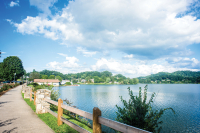Climbers asked to relinquish cliffs for peregrine falcons
Wildlife biologists are asking rock climbers to avoid known nesting habitats of the peregrine falcon as breeding and nesting season approaches.
The peregrine falcon nests atop the high, broad cliffs often used by rock climbers. Once endangered, it was taken off the list 10 years ago. While steady, peregrine numbers in the state are not large, with only 10 to 13 pairs seen each year — all of those in WNC.
“The peregrine falcon is an endangered species success story,” remarked Chris Kelly, a biologist with the N.C. Wildlife Resources Commission. “Key to that success has been the willingness of rock climbers to make concessions for the birds and we hope area rock climbers will continue to be a part of the success.”
The forest service has posted “no climbing” signs on cliffs used as nesting sites by the falcons last year.
Adult birds may abandon a nest if molested, while the young may get scared and bolt off a ledge before they can fly if approached by a climber.
“We understand the sacrifice made by the rock climbers for the birds,” explained Sandy Burnet with the forest service. “We appreciate that sacrifice and hope they know they’re contributing to the peregrine’s success.”
The closure runs through August 15. If falcons aren’t using a site or nesting finishes earlier, it could be opened earlier. If new nesting sites are discovered, they could be added to the list. In this area, the list includes Whiteside Mountain outside Highlands and Looking Glass Rock between Waynesville and Brevard.
A list of the exact climbing routes that are closed is posted at www.cs.unca.edu/nfsnc and www.carolinaclimbers.org.
About the peregrine falcon
The peregrine is a crow-sized raptor that nests on tall cliffs, or even urban skyscrapers. It feeds on other birds and has been known to reach speeds up to 200 miles per hour diving after prey.
Its numbers declined sharply after World War II due to the widespread use of DDT and other pesticides. In 1970 the U.S. Fish & Wildlife Service placed the falcon on the endangered species list.
In 1975 North American peregrine numbers reached an all time low of 324 nesting pairs. The banning of DDT laid the foundation for peregrine recovery. A captive breeding program released more than 6,000 birds in the U.S and Canada between 1974 and 1999, including 92 in WNC.
When it was removed from the endangered species list in 1999, there were at least 1,650 breeding pairs.
Peregrines mate for life and tend to return to the same area each year to mate and nest. They nest once a year, and due to strong territoriality, each cliff site will support only one pair of birds. If the birds abandon the nest or otherwise fail to nest, a year of reproduction is lost.





